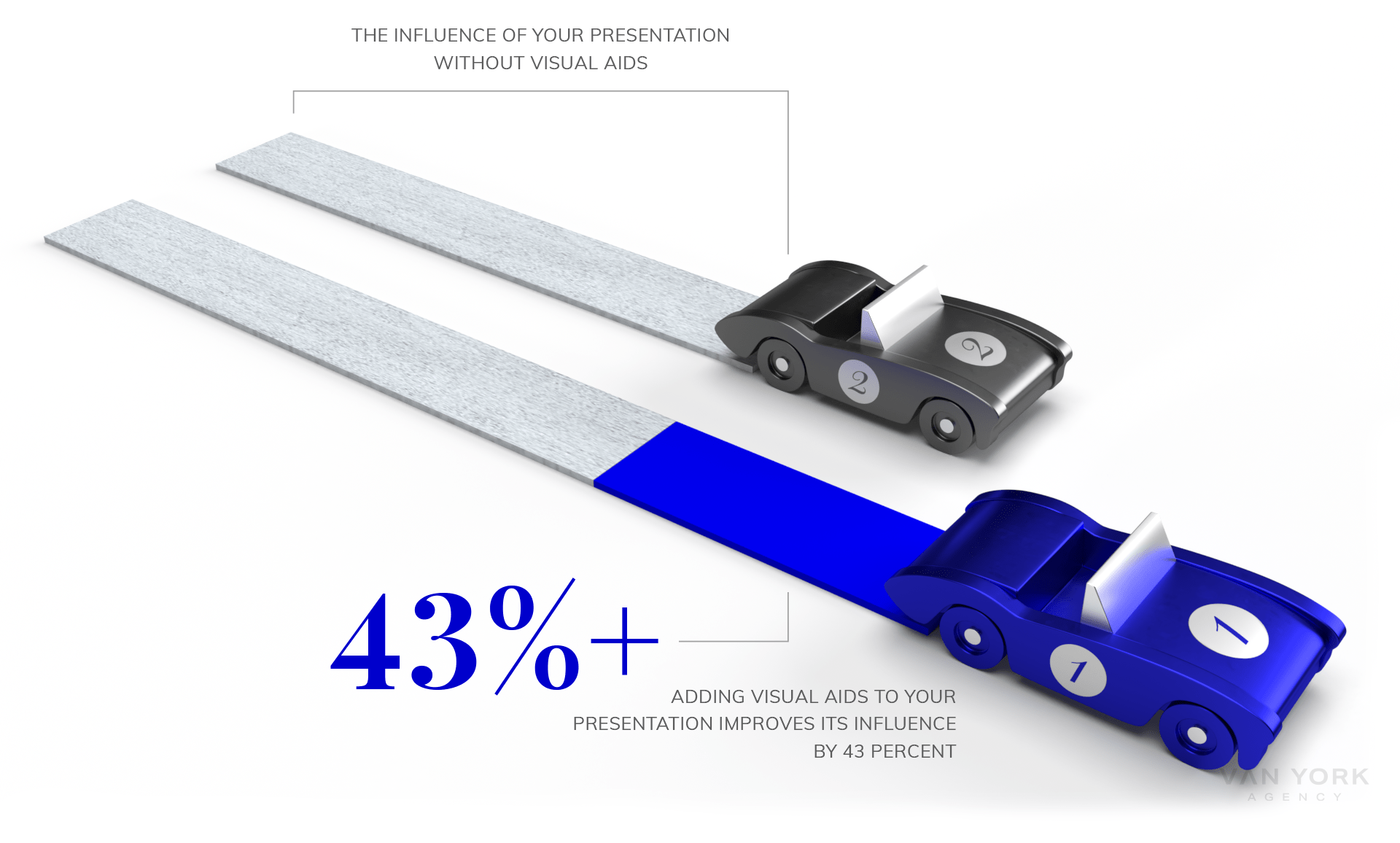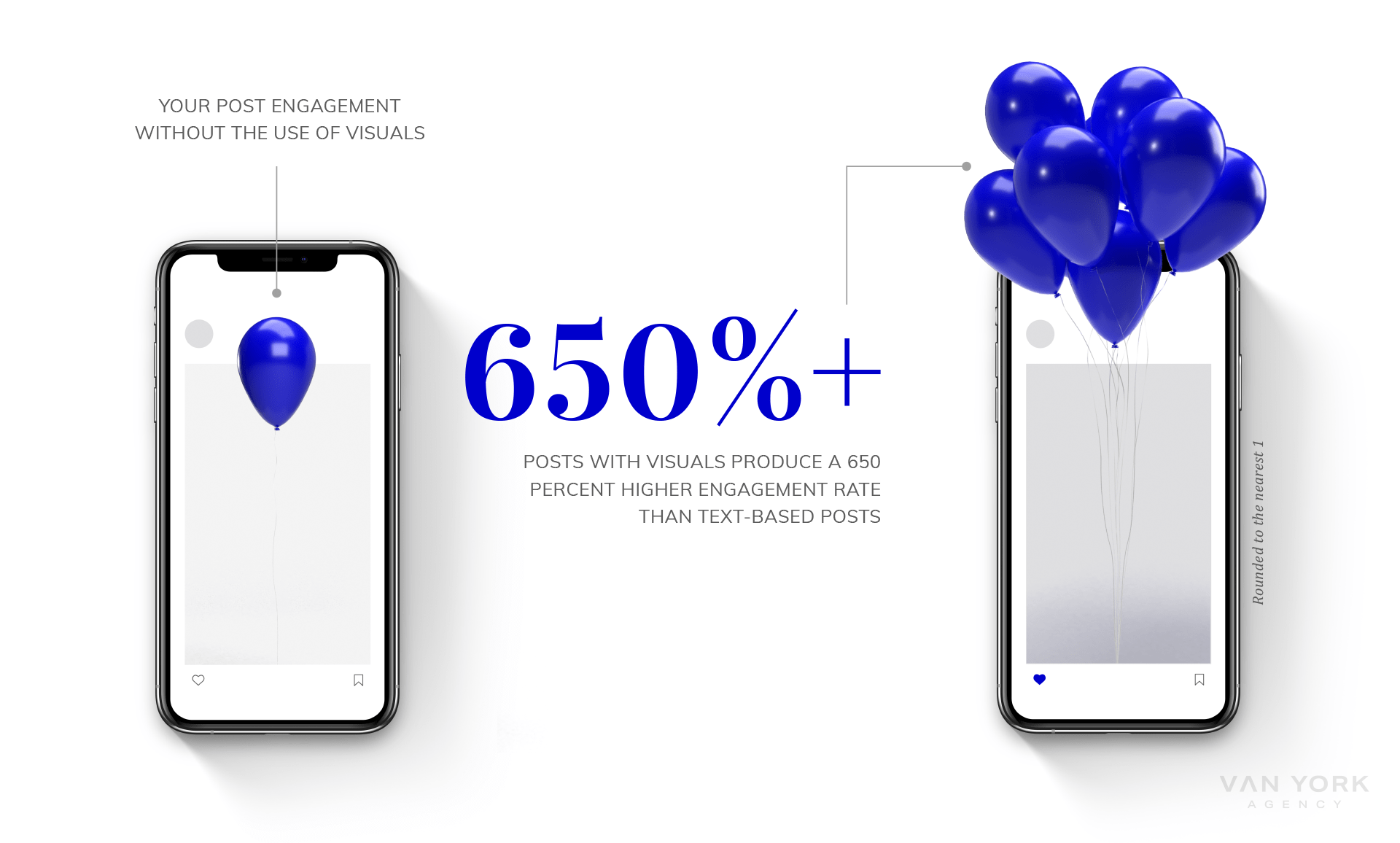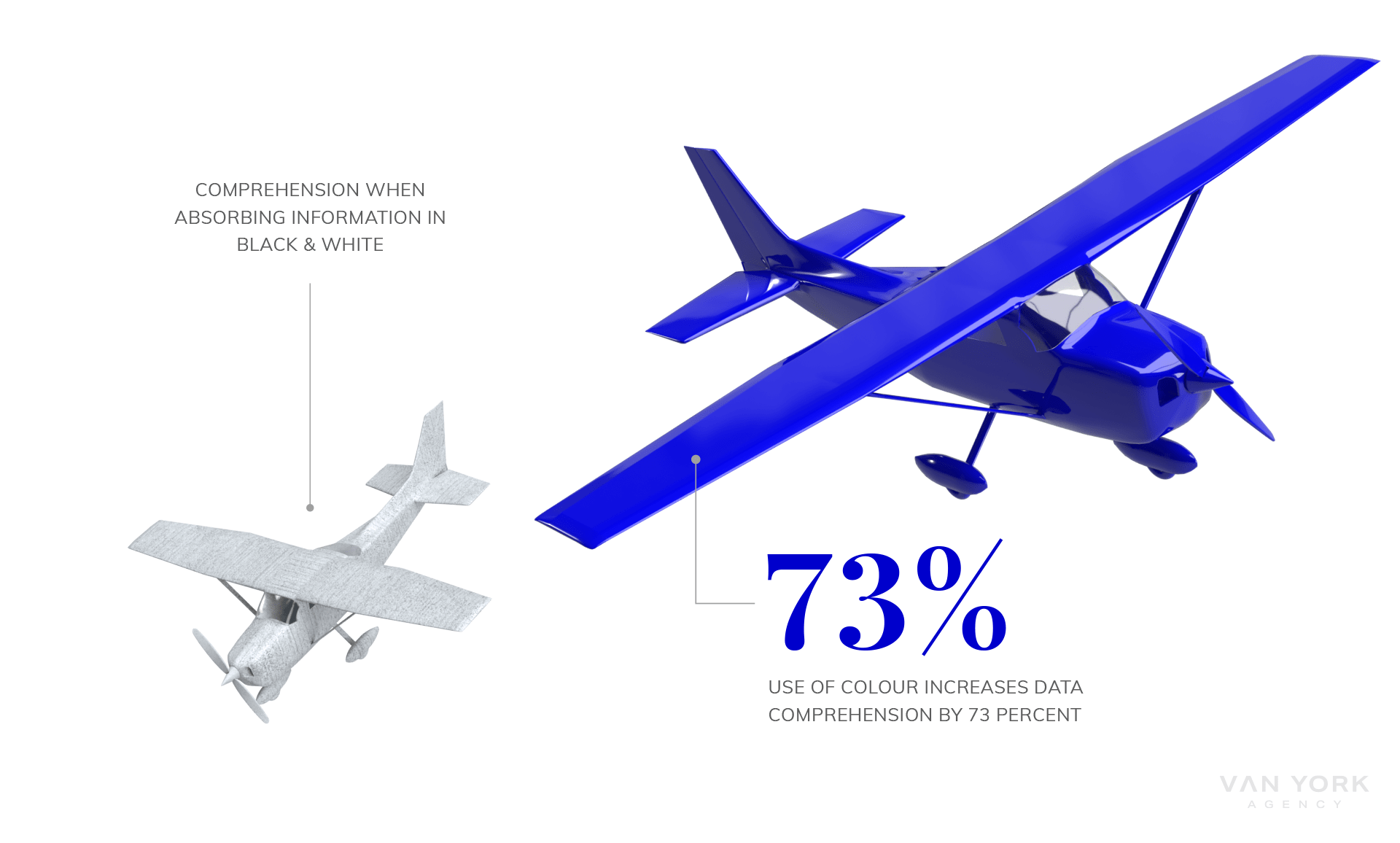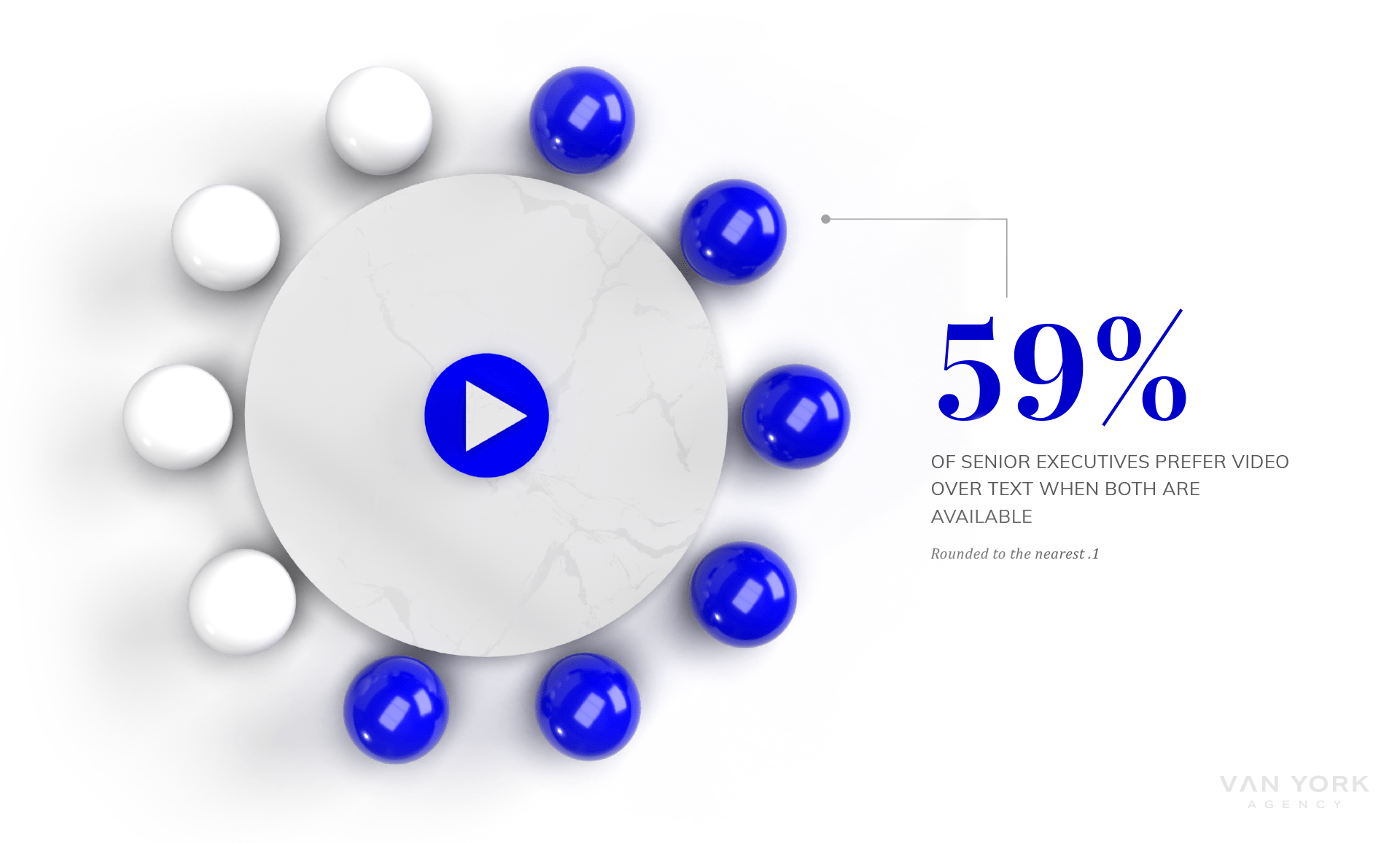By the time you finish reading this sentence, about 30 million emails will have been sent, 720,000 queries will have been posted to Google and over 44,000 stories will have been shared on Instagram [1].
With 4.3 billion+ individuals [2] producing 44 trillion gigabytes of data [3], the information we decide to share with our target audiences is in constant competition for their attention. Engaging visual content is essential now more than ever before, and is one of the most powerful marketing strategies you can employ.
For this reason, it’s important to revisit the ways in which we communicate – from the way we articulate our investor presentations to the way we structure our email campaigns. Adapting a proactive marketing strategy that prioritizes visual content, data visualization and other media is essential for remaining competitive and publishing memorable material.
With cave paintings predating 28,000 years [4], using visual communication tools is not a revolutionary idea. Today, there are new scientific theories that help us understand why they’re so prevalent and effective. In this post, we look at five remarkable metrics pertaining to visual processing and audience retention, and discuss how they can be applied to your marketing strategy.
1. Presentations with visuals are 43% more persuasive than text-based presentations.
A study conducted by researchers from the University of Minnesota and 3M Corporation found that presentations using visual aids (colourful charts, graphs and images) were 43% more persuasive than black and white text-based presentations. [5]
What it means for your business
According to the study, adding visuals to presentations helps improve audience attention and influence action. Visual content facilitates the absorption of data, helping illustrate information that might require further elaboration. This creates a more informative and palatable reading experience. Your business plan is a catalogue of diverse information and data, but also serves to be an effective marketing document. A strong business plan will be one that both anticipates and answers an investor’s questions. Using visuals to organize complex data or support abstract concepts will make for an easily digestible report, presented as a convincing and compelling proposal.
2. Posts with visuals produce a 650% higher engagement rate than text-based posts.
According to the Adobe Digital Index Social Intelligence Report, content paired with visuals (such as images and graphics) yielded a 650% higher engagement rate than standard text posts. [6]
What it means for your business
The way modern audiences consume information has changed. A 2008 study conducted by the Nielsen Norman Group found that, among a data set of 45,000+ web page visits, users read about 20% of the words on the average page. [7] Alternatively, MIT researchers have found that individuals can process the meaning of an image in as little as 13 milliseconds [8] – about 10 times faster than the blink of an eye! [9] These separate studies offer some insight into why image posts produce such a high engagement rate – individuals are naturally more inclined to consume visual information. When looking for ways to reach your target audience, whether through a social media or email campaign, visual content can go a long way in generating customer engagement.
What it means for your business
Colour decisions for brand identities and marketing collateral go far beyond superficial aesthetics. The relationships between colours and human psychological functions have been studied since 1810 [12], and scholars have since been building upon theories that suggest how certain colours impact emotional experience and cognitive processing. Strategic storytelling, whether by way of pitch deck or product packaging design, seeks to inform as much as it serves to elicit an emotional response. Careful considerations of colour palettes and their uses throughout your marketing materials can dramatically impact how well those materials are received.
4. 59% of senior executives prefer video over text when both are available.
A 2010 Forbes Insights study, in association with Google, surveyed 306 executives, and found that 59% of the participants opted for video content when the information was available in both video and text form. [13]
What it means for your business
Congruent with the Nielsen Norman study referenced in #2, the Forbes Insights survey found that individuals prefer more convenient means of absorbing information. Videos, from animated explainer videos to 3D virtual modeling, are increasingly permeating social media as much as they are finding their way into the C-Suite. In fact, organizations in professional services, communications and technology were among a small group of industries that published over 300 videos in 2018 [14]. Using videos to educate or influence an audience is one of the most effective means of communication today, and can significantly enhance your storytelling strategy – in both the boardroom and the newsfeed.
5. 49% of business professionals are more discerning with the content they consume.
According to Prezi’s 2018 State of Attention Report, nearly half of all business professionals admit to being more selective about the content they choose to consume. [15] Once engaged, 59% of respondents claim they can give a piece of content their undivided attention.
What it means for your business
While the myth regarding shrinking attention spans has been debunked, the range of content readily available for consumption is increasing by the minute. Prezi’s report found that 95% of business professionals admit to multitasking during meetings. This is not due to an innate inability to focus – it’s a conscious decision to choose one source of information over another. For example, if you’re making your pitch without providing value to your audience, they might lose interest and redirect their attention to things that do bring them value – perhaps an unopened email or a pending transaction.
There are ways to mitigate these challenges. The same study found that visual content was incredibly effective in capturing individuals’ attention, with 79% of respondents asserting that animated visuals helped keep their audiences engaged. Research also finds that visuals are much more memorable than text [16]. When preparing for an important meeting with investors or business partners, it’s important to keep in mind that each individual in the room is making a choice to listen and participate – and they can just as easily make the choice to redirect their attention if your presentation isn’t compelling enough.
In Summary:
There are countless techniques a business or individual can employ to communicate their message. Successful storytellers craft their narratives by speaking the language of their audiences. Anticipating your readers’ questions (e.g. “Why should I invest?” “Why should I make a purchase?” “Why should I care about this?”) and answering them in an eloquent, easily-digestible format is the key to crafting a compelling presentation. Visual content – from an interesting infographic in your business plan to an animated video in your social media campaign – is an effective vehicle for relaying engaging and memorable information, and should be a top priority for your 2020 marketing strategy.
Note: All graphics and data visualization featured in this post were created by Van York Agency Inc.
References
[1] Data Never Sleeps 7.0. (2019). DOMO.
[2] Silver, L. (2019). Smartphone Ownership Is Growing Rapidly Around the World, but Not Always Equally. Pew Research Center.
[3] A Day in Data. (2019). Raconteur.
[4] Gunn, R., David, B., Delannoy, J.J. & Katherine, M. (2017). The past 500 years of rock art at Nawarla Gabarnmang, central-western Arnhem Land, The Archeology of Rock Art in Western Arnhem Land, Australia. 303-328.
[5] Vogel, D. R., Dickson, G. W. & Lehman, J. A. (1986). Persuasion and the Role of Visual Presentation Support: The UM/3M Study.
[6] Social Intelligence Report Q4 2013. Adobe Digital Index.
[7] Weinreich, H., Obendorf, H., Herder, E. & Mayer, M. Not Quite the Average: An Empirical Study of Web Use, ACM Transactions on the Web, Vol. 2.
[8] Wyble, B., Potter, M.C., Hagmann, C, & McCourt, E.S. (2013). Detecting meaning in RSVP at 13 ms per picture, Attention, Perception, & Psychophysics. 76, 2. 270–279.
[9] Bristow, D., Haynes, J.D., Sylvester, R., Frith, C., & Rees, G. (2005). Blinking suppresses the neural response to unchanging retinal stimulation, Current Biology. 15, 4.
[10] Business Papers in Color. Just a Shade Better. Modern Office Technology, 34, 7. 98-102.
[11] Johnson, V. (1992). The Power of Color. Successful Meetings, 41, 7. 87-90.
[12] Elliot, A.J. (2015). Color and psychological functioning: a review of theoretical and empirical work. Frontiers in Psychology.
[13] Rizy, C., Feil, S., Sniderman, B. & Millar, B. (2010). Video in the C-Suite: Executives Embrace the Non-Text Web. Forbes Insights.
[14] 2019 Video in Business Benchmark Report. Vidyard.
[15] Lacerdino, I. (2019). 2018 State of Attention. Prezi.
[16] Stenberg, G. (2006). Conceptual and perceptual factors in the picture superiority effect. European Journal of Cognitive Psychology. 1-35.

Katya Polo is a business development professional with both an MBA and over a decade of digital design experience. Specializing in both strategic planning and brand development, Katya has produced 75+ business plans and pitch decks that have helped raise over $1.3 billion in investment capital.
How can we help you?
Get in touch with us to speak with a consultant and start working with a multi-functional marketing agency.







